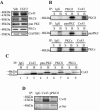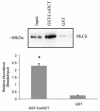Interaction of connexin43 and protein kinase C-delta during FGF2 signaling
- PMID: 20338032
- PMCID: PMC2855512
- DOI: 10.1186/1471-2091-11-14
Interaction of connexin43 and protein kinase C-delta during FGF2 signaling
Abstract
Background: We have recently demonstrated that modulation of the gap junction protein, connexin43, can affect the response of osteoblasts to fibroblast growth factor 2 in a protein kinase C-delta-dependent manner. Others have shown that the C-terminal tail of connexin43 serves as a docking platform for signaling complexes. It is unknown whether protein kinase C-delta can physically interact with connexin43.
Results: In the present study, we investigate by immunofluorescent co-detection and biochemical examination the interaction between Cx43 and protein kinase C-delta. We establish that protein kinase C-delta physically interacts with connexin43 during fibroblast growth factor 2 signaling, and that protein kinase C delta preferentially co-precipitates phosphorylated connexin43. Further, we show by pull down assay that protein kinase C-delta associates with the C-terminal tail of connexin43.
Conclusions: Connexin43 can serve as a direct docking platform for the recruitment of protein kinase C-delta in order to affect fibroblast growth factor 2 signaling in osteoblasts. These data expand the list of signal molecules that assemble on the connexin43 C-terminal tail and provide a critical context to understand how gap junctions modify signal transduction cascades in order to impact cell function.
Figures






Similar articles
-
The regulation of runt-related transcription factor 2 by fibroblast growth factor-2 and connexin43 requires the inositol polyphosphate/protein kinase Cδ cascade.J Bone Miner Res. 2013 Jun;28(6):1468-77. doi: 10.1002/jbmr.1867. J Bone Miner Res. 2013. PMID: 23322705 Free PMC article.
-
ERK acts in parallel to PKCδ to mediate the connexin43-dependent potentiation of Runx2 activity by FGF2 in MC3T3 osteoblasts.Am J Physiol Cell Physiol. 2012 Apr 1;302(7):C1035-44. doi: 10.1152/ajpcell.00262.2011. Epub 2012 Jan 25. Am J Physiol Cell Physiol. 2012. PMID: 22277757 Free PMC article.
-
Connexin43 potentiates osteoblast responsiveness to fibroblast growth factor 2 via a protein kinase C-delta/Runx2-dependent mechanism.Mol Biol Cell. 2009 Jun;20(11):2697-708. doi: 10.1091/mbc.e08-10-1079. Epub 2009 Apr 1. Mol Biol Cell. 2009. PMID: 19339281 Free PMC article.
-
Connexin43 phosphorylation and cytoprotection in the heart.Biochim Biophys Acta. 2012 Aug;1818(8):2009-13. doi: 10.1016/j.bbamem.2011.06.023. Epub 2011 Jul 3. Biochim Biophys Acta. 2012. PMID: 21763271 Review.
-
Molecular mechanisms of osteoblast/osteocyte regulation by connexin43.Calcif Tissue Int. 2014 Jan;94(1):55-67. doi: 10.1007/s00223-013-9742-6. Epub 2013 Jun 11. Calcif Tissue Int. 2014. PMID: 23754488 Free PMC article. Review.
Cited by
-
Low Level Pro-inflammatory Cytokines Decrease Connexin36 Gap Junction Coupling in Mouse and Human Islets through Nitric Oxide-mediated Protein Kinase Cδ.J Biol Chem. 2016 Feb 12;291(7):3184-96. doi: 10.1074/jbc.M115.679506. Epub 2015 Dec 14. J Biol Chem. 2016. PMID: 26668311 Free PMC article.
-
GJB2 c.35del variant up-regulates GJA1 gene expression and affects differentiation of human stem cells.Genet Mol Biol. 2024 Apr 15;47(2):e20230170. doi: 10.1590/1678-4685-GMB-2023-0170. eCollection 2024. Genet Mol Biol. 2024. PMID: 38626573 Free PMC article.
-
Connexin43 in Musculoskeletal System: New Targets for Development and Disease Progression.Aging Dis. 2022 Dec 1;13(6):1715-1732. doi: 10.14336/AD.2022.0421. eCollection 2022 Dec 1. Aging Dis. 2022. PMID: 36465186 Free PMC article.
-
Up-regulation of BMP2/4 signaling increases both osteoblast-specific marker expression and bone marrow adipogenesis in Gja1Jrt/+ stromal cell cultures.Mol Biol Cell. 2015 Mar 1;26(5):832-42. doi: 10.1091/mbc.E14-06-1136. Epub 2015 Jan 7. Mol Biol Cell. 2015. PMID: 25568340 Free PMC article.
-
Bone fracture healing: perspectives according to molecular basis.J Bone Miner Metab. 2021 May;39(3):311-331. doi: 10.1007/s00774-020-01168-0. Epub 2020 Nov 5. J Bone Miner Metab. 2021. PMID: 33151416 Review.
References
Publication types
MeSH terms
Substances
Grants and funding
LinkOut - more resources
Full Text Sources
Molecular Biology Databases
Miscellaneous

